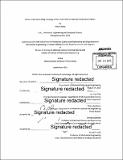Numerically generating topology of the liner finish in internal combustion engines
Author(s)
Wang, Renze, S.M. Massachusetts Institute of Technology
DownloadFull printable version (13.72Mb)
Other Contributors
Massachusetts Institute of Technology. Department of Mechanical Engineering.
Advisor
Tian Tian.
Terms of use
Metadata
Show full item recordAbstract
Internal combustion (IC) engines are broadly utilized today. The friction caused by piston rings in IC engines contributes around 20% of the mechanical friction losses. The liner finish is the most critical parameter to define the tension and other design parameters of the piston rings for proper sealing. This work is focused on developing numerical approaches to generating liner finishes based on certain values of topology parameters. The generated surface is able to simulate the lubrication and dry contact behaviors of the original surface, so that the method is used to study the effects of various topology parameters on friction losses. First, methods to analyze, generate, test, and compare honed liner surfaces have been developed. The algorithm to analyze the topology parameters of honed surfaces is described. The honed surfaces are numerically generated and compared with the experimental data. Moreover, the topological variables are changed and the corresponding friction behaviors are studied. The relations between topology variables and friction losses are illustrated. We also developed a quantitative relation between two ISO standards describing the honed liner finish, so that the manufacturing industry can use the surface generation method in convenience. Second, attempts were made to simulate the break-in processes for honed liner finish. Measured and numerically generated surfaces are simulated and compared. The friction and pressure behaviors for lightly and heavily worn surfaces are compared with experimental data. Moreover, by tuning the worn parameters, the friction effective mean pressure (FMEP) curve can match the experimental data. Finally, the algorithm to numerically generate thermally sprayed liner finish is described. The hydrodynamic and dry contact friction behaviors for generated surfaces are compared with experimental data. Critical topology parameters are tuned and their effects on friction losses are studied. Moreover, the effects of the pores created by the plasma spraying processes on the lubrication behaviors are simulated.
Description
Thesis: S.M., Massachusetts Institute of Technology, Department of Materials Science and Engineering, 2015. Thesis: S.M., Massachusetts Institute of Technology, Department of Mechanical Engineering, 2015. Cataloged from PDF version of thesis. Includes bibliographical references (pages 74-77).
Date issued
2015Department
Massachusetts Institute of Technology. Department of Materials Science and Engineering; Massachusetts Institute of Technology. Department of Mechanical EngineeringPublisher
Massachusetts Institute of Technology
Keywords
Materials Science and Engineering., Mechanical Engineering.